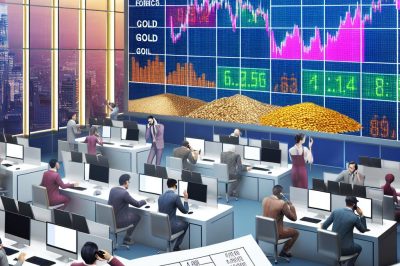Introduction to Commodity Trading
Commodity trading involves the transaction of raw materials and primary agricultural products. These are typically categorized into hard and soft commodities. Hard commodities consist of natural resources that require extraction, such as oil, gold, and metals, while soft commodities include agricultural products like wheat, livestock, and coffee.
Understanding the Commodity Market
The commodity market provides a platform for the trading of goods. This market facilitates transactions on both spot markets, where commodities are immediately delivered, and futures markets, where goods are exchanged based on contracts for future delivery. By doing so, the market enables producers and consumers to hedge against potential future price fluctuations, contributing to operational stability.
Commodity Exchanges
Trading of commodities predominantly occurs on established, regulated exchanges under standardized contracts. Notable commodity exchanges include:
– The Chicago Mercantile Exchange (CME), which is recognized for its trading in agricultural products and financial derivatives.
– The Intercontinental Exchange (ICE), which is another key player in the field.
– The London Metal Exchange (LME), known for its specialization in metal trading.
Each of these exchanges brings its expertise to specific commodity types, allowing for a diverse array of trading options.
Types of Commodities Traded
In addition to hard and soft commodities, the market categorizes commodities based on their economic functions. This division makes the market broad and includes the following categories:
1. Energy: Encompassing crude oil, natural gas, and heating oil.
2. Metals: Incorporating commodities such as gold, silver, copper, and aluminum.
3. Agriculture: That covers grains, sugar, cotton, and livestock.
4. Environmental: Which involves carbon credits and renewable energy certificates.
Each of these categories plays a significant role in the market’s dynamism and the extensive range of trading activities observed.
The Role of Speculators and Hedgers
The participants within the commodity market generally fall into two main categories: hedgers and speculators.
– Hedgers are primarily producers or consumers aiming to lock in prices to mitigate uncertainties and manage risks. For instance, a farmer leveraging futures contracts to secure specific prices for their crop exemplifies a hedger’s strategic approach to ensure financial stability amid fluctuating market conditions.
– Conversely, speculators are entities driven by profit. They aim to capitalize on price changes and use futures and options to obtain financial exposure, even though they do not necessarily take physical possession of the commodities involved. This behavior injects liquidity and efficiency into the market, although it also amplifies volatility.
Risks and Challenges in Commodity Trading
Trading in commodities is inherently risky due to its association with high volatility. Commodity prices are frequently affected by unforeseen factors including weather conditions, geopolitical dynamics, and shifts in economic indicators. Participants must remain vigilant of the applicable risks, which encompass:
– Market Risk: The potential for losing money due to adverse price movements.
– Credit Risk: The risk associated with the failure of a counterparty to fulfill contractual obligations.
– Operational Risk: Risks arising from internal process failures.
Despite these challenges, commodity trading is essential for the global economy. It not only facilitates a steady supply of raw materials and agricultural products but also renders opportunities for both hedging and speculation. This makes the market attractive to a diverse range of financial participants.
For those keen on exploring further, resources and detailed materials from recognized commodity exchanges such as the CME Group or the ICE are available. Additionally, those seeking to understand the intricacies of options and futures might find valuable insights through commodity-option-training.com, a robust educational platform offering specialized training in commodity options.
In conclusion, while the challenges in commodity trading are formidable, the benefits it presents make it a compelling component of the financial markets landscape. Its capacity for providing economic balance through hedging techniques is unparalleled, and for speculators, it offers a chance to reap financial rewards amidst informed risk management. Whether one’s goal is risk mitigation or profit maximization, the realm of commodity trading offers distinct pathways to achieve financial objectives.





